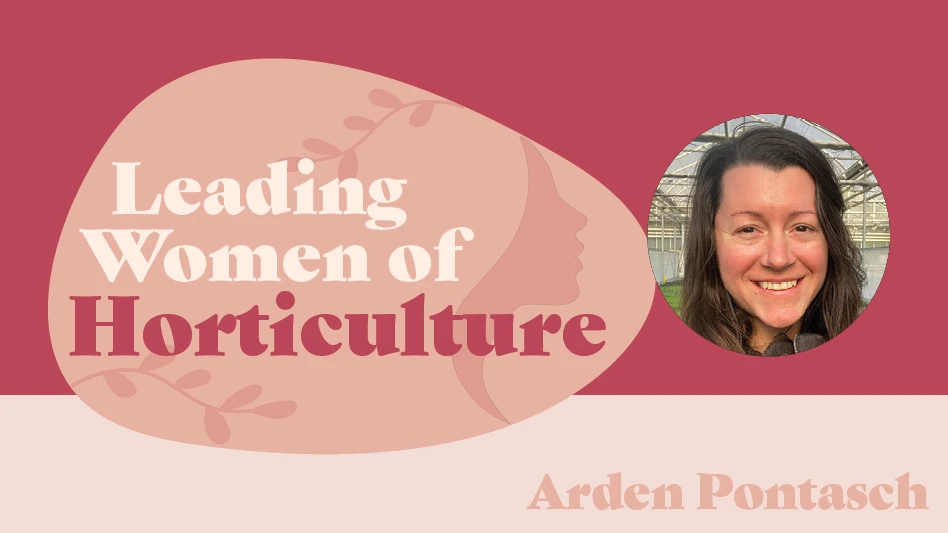 Efforts to find alternatives to costly or non-renewable potting media components have often gone hand in hand with efforts to find useful applications for agricultural by-products that would otherwise be treated as a waste liability. Peat has been a major potting media component for decades, but concerns over the environmental damage caused by its harvest have fostered a search for alternatives. Numerous problems are also associated with the storage and disposal of animal manure. Anaerobically digested dairy fiber (ADDF) has the potential to serve both as a replacement for peat in potting media and to reduce some problems associated with dairy manure.
Efforts to find alternatives to costly or non-renewable potting media components have often gone hand in hand with efforts to find useful applications for agricultural by-products that would otherwise be treated as a waste liability. Peat has been a major potting media component for decades, but concerns over the environmental damage caused by its harvest have fostered a search for alternatives. Numerous problems are also associated with the storage and disposal of animal manure. Anaerobically digested dairy fiber (ADDF) has the potential to serve both as a replacement for peat in potting media and to reduce some problems associated with dairy manure.
Anaerobically digested dairy fiber is a by-product of methane extraction from dairy manure. Anaerobic digestion has been proposed as a more environmentally sound way to process livestock manure while limiting greenhouse gas emissions. Anaerobic digestion is a controlled decomposition of organic material much like composting, only as the name implies, it take place under anaerobic (without oxygen) conditions. Anaerobic digestion produces methane gas which can be used as a biofuel rather than escaping into the atmosphere as a greenhouse gas. The liquid and solid material that is left over after anaerobic digestion are separated and the solid fraction is ADDF.
Peat, much like ADDF, is also formed under anaerobic conditions found in natural peat bogs. Peat and ADDF have many similarities in physical properties, such as porosity, water holding capacity and bulk density. Previous trials using ADDF as a peat replacement in media for floriculture and greenhouse crops have had promising results. Nursery crops are generally more robust than greenhouse crops and may be even more resilient to new and alternative growing media. The longer growing season of nursery crops presents a need to further investigate the physical properties of ADDF over time, particularly shrinkage.
Using ADDF in nursery media has the potential to benefit dairy farmers, growers and the environment. Dairy farmers would be able to sell ADDF as a horticultural product rather than having to dispose of it as a hazardous waste. Growers could market plants grown in ADDF as more sustainable or local than plants grown using peat from Canada. It is possible that ADDF, which would otherwise be treated as a waste liability, could be less expensive than peat, too.
Plant trials with ADDF
Three nursery plant growth trials were conducted at The University of Connecticut to evaluate ADDF as a potential replacement for peat in nursery media. A wide variety of nursery crops were tested to determine the versatility of ADDF. Two woody crops from liners, two woody crops from cuttings, and five herbaceous nursery crops were tested. The four mixes used for these trials had a 4:2:1 ratio of bark-peat-sand, bark-ADDF-sand, bark-peat-perlite or bark-ADDF-perlite. The ADDF was sourced from a local dairy farmer. ADDF is alkaline in reaction so both ADDF-containing mixes were amended with gypsum in place of lime to supply calcium without raising the pH.
Along with plant growth response, media shrinkage and nutrient leaching were evaluated. Previous trials with floriculture crops grown in ADDF showed that ADDF contains significant amounts of plant available phosphorus. Plant available phosphorus is also easily leached and lost to the environment. Trials using potential peat alternatives similar to ADDF (composted cow manure, spent mushroom compost and other composts) have shown that nutrient leaching could be problematic. Additionally, some composts that have been proposed as replacements for peat have proven to be unsuitable for long-term nursery crops because they decompose too quickly, leading to media shrinkage and compaction.
The anaerobic processing of ADDF may make it more stable than aerobically processed composts and less susceptible to shrinkage and compaction.
Woody crops from cuttings
Ninebark (Physocarpus opulifolius) and cranberry bush viburnum (Viburnum opulus) rooted cuttings were then transplanted into 2½-inch establishment pots filled with either bark-peat-sand or bark-ADDF-sand mixes and grown outdoors with overhead irrigation for one growing season. Plants were not fertilized so that any plant growth response to additional nutrition provided by ADDF would be more apparent. Plants were forced out of dormancy in a greenhouse after overwintering in a cold frame. After leafing out, plant growth was evaluated by measuring dry weight, height and with a subjective visual quality evaluation.
 There were no noticeable differences between plants grown in the two mixes at the end of the first growing season, however, at the beginning of the second season both crops grown in the bark-ADDF-sand mix broke dormancy more quickly, vigorously and with darker foliage. At harvest, both ninebark and viburnum grown in the bark-ADDF-sand mix were significantly taller than the plants grown in bark-peat-sand mix. There was no difference in dry weight between viburnum grown in either mix but the dry weight of ninebark grown in the bark-ADDF-sand mix was greater than in the bark-peat-sand mix.
There were no noticeable differences between plants grown in the two mixes at the end of the first growing season, however, at the beginning of the second season both crops grown in the bark-ADDF-sand mix broke dormancy more quickly, vigorously and with darker foliage. At harvest, both ninebark and viburnum grown in the bark-ADDF-sand mix were significantly taller than the plants grown in bark-peat-sand mix. There was no difference in dry weight between viburnum grown in either mix but the dry weight of ninebark grown in the bark-ADDF-sand mix was greater than in the bark-peat-sand mix.
Woody crops from liners
Button bush (Cephalanthus occidentalis) and silky dogwood (Cornus amomum) liners were transplanted into #2 pots containing either the bark-ADDF-sand mix or the bark-peat-sand mix. Plants were fertilized with a top dressing of Osmocote 18-6-12. During the first growing season, plants were grown outdoors under drip irrigation. Plants were overwintered in an unheated hoop house and moved to a double polyethylene film greenhouse to break dormancy under overhead irrigation. At the end of the first growing season plant height, width, stem caliper and number of shoots were measured. After leafing out at the beginning of the second season, final measures of plant height, leaf tissue nutrient concentration, and shoot fresh and dry weight were collected. Media shrinkage was measured twice; once at the end of the first season and again upon harvest at the beginning of the second season. Media physical properties including bulk density and water holding capacity were measured before planting and again upon harvest in the second season. PourThru samples were taken throughout the first season to monitor any potential nutrient leaching.
There were no differences in any of the measured plant growth parameters at the end of the first season or upon harvest in the second season. While both mixes had similar bulk densities at the end of the trial, the ADDF-containing mix ultimately had a lower water holding capacity than the peat mix. There was more shrinkage in the bark-peat-sand mix in the first season under drip irrigation whereas the bark-ADDF-sand mix experienced more shrinkage during the second season under overhead irrigation. There was no difference in the total shrinkage from both seasons between the two mixes. Analysis of PourThru samples from the first season showed there were elevated quantities of phosphate in the bark-ADDF-sand mixes as compared to the bark-peat-sand mix throughout the whole growing season.
Herbaceous nursery crops
A variety of herbaceous perennials including plugs of Brunnera macrophylla ‘Jack Frost,’ Leucanthemum superbum ‘Whoops-a-Daisy’ and divisions of Phlox paniculata ‘David,’ Liatris spicata ‘Kobold Original’ and Coreopsis verticillata ‘Moonbeam’ were transplanted in pots (approximately 2.8L volume) containing either the bark-ADDF-perlite or bark-peat-perlite mix. Plants were top dressed with Osmocote 18-6-12 and grown in a glass greenhouse under overhead irrigation. Growth and quality of each species was evaluated based on quantitative parameters appropriate its growth habits and a subjective visual evaluation. For brunnera, the number of flower spikes, maximum flower spike length and canopy volume were measured. For coreopsis, dry weight was measured. For Leucanthemum, dry weight and number of flowers were measured. For, liatris, dry weight, number of flower stems and maximum height were measured. For phlox, dry weight, number of stems and maximum height were measured. Leachate from each irrigation event was collected and analyzed for phosphate to calculate the cumulative amount leached.
There were no difference in measured plant growth parameters between the two mixes except for greater fresh and dry weights of Leucanthemum grown in the bark-ADDF-perlite mix. Mild chlorosis was observed in coreopsis and brunnera gown in the bark-ADDF-perlite mix. Overall, plant growth in the bark-ADDF-perlite mix appeared to have somewhat greater variability than in the bark-peat-perlite mix. Many plants in the bark-ADDF-perlite mix grew to an acceptable size and quality while a few individuals were severely stunted.
A much greater amount of phosphate was leached from pots containing the bark-ADDF-perlite mix and continued to be released through the growing season of all crops tested.
Final analysis
ADDF can be used as a complete replacement for peat in media for a variety of nursery crops. Overall, plants grown in the ADDF-containing mixes were of equal or better size and quality to those grown in the peat-containing mixes. All management decisions for these trials were based on a peat-containing mix not adjusted to account for differences between peat and ADDF.
ADDF mixes have a high potential for phosphorus leaching. Low phosphorus fertilizer and irrigation that minimizes runoff should be used. It seems that overhead irrigation leads to more shrinkage in ADDF-containing media so a drip system may be the best option to limit both shrinkage and runoff.
There may be regional or seasonal differences in the manure feedstock used to produce ADDF. These differences could lead to differences in physical properties and chemical composition of the final ADDF product. Some of the variability in growth results in the herbaceous nursery crop trial may have been due to non-uniformity of ADDF used in the mixes.
Using ADDF as an alternative media component offers exciting opportunities to both dairy farmer and growers. This research shows that ADDF is a viable alternative to peat in nursery media for a diversity of nursery crops.
John R. Lamont was a Master’s student in the plant science department at The University of Connecticut. He is now pursuing a PhD in plant science at McGill University. Dr. George C. Elliott has served as a professor of horticulture at The University of Connecticut since 1989.

Explore the December 2015 Issue
Check out more from this issue and find your next story to read.
Latest from Nursery Management
- Plant breeding as an art
- Society of American Florists accepting entries for 2025 Marketer of the Year Contest
- Sustainabloom launches Wholesale Nickel Program to support floriculture sustainability
- American Horticultural Society welcomes five new board members
- Get to know Christopher Brown Jr. of Lancaster Farms
- American Floral Endowment establishes Demaree Family Floriculture Advancement Fund
- The Growth Industry Episode 3: Across the Pond with Neville Stein
- The Growth Industry Episode 2: Emily Showalter on how Willoway Nurseries transformed its business





